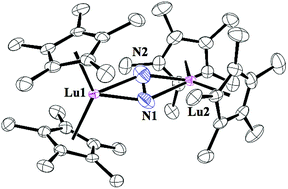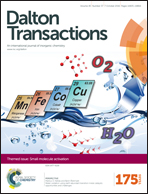Raman spectroscopy of the N–N bond in rare earth dinitrogen complexes†
Abstract
Raman spectra have been collected on single crystals of over 20 different rare earth complexes containing reduced dinitrogen ligands to determine if these data will correlate with periodic properties or relative stability. Four types of complexes were examined: [(C5Me5)2Ln]2(μ–η2:η2-N2), 1-Ln, [(C5Me4H)2(THF)Ln]2(μ–η2:η2-N2), 2-Ln, [(C5H4Me)2Ln]2(μ–η2:η2-N2), 3-Ln, and {[(Me3Si)2N]2(THF)Ln}2(μ–η2:η2-N2), 4-Ln. Although each of the complexes contains a side-on bound dinitrogen ligand that is formally (N2)2−, the N–N bond distances determined by X-ray crystallography range from 1.088(12) to 1.305(6) Å. In the 4-Ln series (Ln = Gd, Tb, Dy, Ho, Er and Tm), the 1.26–1.31 Å N–N distances do not follow any periodic trends, but the Raman stretching frequencies for Gd–Tm were found to decrease regularly with decreasing atomic number and increasing Lewis acidity of the metal. Similar correlations can be seen with the late metals in complexes of the other series, 1-Ln, 2-Ln and 3-Ln, but exceptions exist, particularly for the larger metals. Comparisons between the several types of complexes as a function of ligand were more complicated and variations in stretching frequency as a function of L in the {[(Me3Si)2N]2Y(L)}2(μ–η2:η2-N2) substituted versions of 4-Y did not give trends consistent with bond distances or Gutmann donor numbers.

- This article is part of the themed collections: Celebrating the 2017 RSC Prize and Award Winners and Small Molecule Activation

 Please wait while we load your content...
Please wait while we load your content...